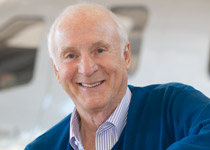Fate really is the hunter
A Douglas DC–4 plays a major role
At approximately the point of no return, the left outboard engine experiences a catastrophic failure, flings its propeller far into the night, and ruptures a fuel tank. It is questionable as to whether the airplane can make it to San Francisco. Ernest K. Gann wrote the screenplay, which is based on his novel of the same title. The book was on The New York Times Best Sellers list for 57 weeks.
Another star of the movie was the military Douglas C–54A Skymaster that had been transitioned into civilian life as a Douglas DC–4 bearing registration N4726V. When used in the film it was owned by Transocean Air Lines, which at that time had the largest fleet of DC–4s. Transocean is also where a certain pilot, Ernest Gann, continued to experience more of the exciting adventures about which he so masterfully wrote. (This DC–4 had previously been the personal airplane of former Argentine president Juan Perón.)
On March 28, 1964, 10 years after first appearing as an airliner in distress on the silver screen and having been sold to a corporate operator, N4726V departed on an actual flight from Hawaii to California. While en route, the crew sent a mayday message via high-frequency radio and reported such a “bad fire” in the number two (left inboard) engine that a ditching at night might become necessary. This was the last transmission heard from the flight.
The airplane had experienced a maintenance delay on this trip. Among the causes was a recurring oil leak in the propeller governor of the number two engine.
Coast Guard, Air Force, and Navy flights from the aircraft carrier USS Kearsarge conducted an extensive five-day search 700 to 1,000 miles southwest of San Francisco. There was no sign of the disabled airliner. It was presumed that the ditching occurred before dawn in 10-foot swells and a 30-mph wind, an extremely challenging set of conditions in which to ditch. It was hoped that some or all of the three crewmembers and six passengers would have been found adrift in life rafts, but this was not to be, even though separate sources reported hearing SOS signals an hour apart. The signals were believed to have come from a “Gibson Girl,” a hand-crank transmitter of the type with which each of the two aircraft rafts were equipped. The signals were too weak, however, to obtain a bearing.
Fiction had become reality. Fate had become the victor, just as Gann had written in his 1961 memoir, Fate is the Hunter, regarded by many—including this writer—as a classic, the best, and apparently most prophetic, aviation book of all time.
A Douglas DC–4 also played a major role in my life. During the week of my thirteenth birthday in 1951, my parents sent me to New Jersey to spend the summer with my grandparents. This was because I had become “somewhat of a juvenile delinquent” and needed to be removed from the influence of those with whom I was “going astray.”
My father deposited me at the Burbank Airport (BUR) where I boarded a North American Airlines DC–4, my very first flight. It whisked me to New York’s LaGuardia Airport (LGA) via Wichita and Chicago Midway. During each leg I stared in fascination at the endless, motionless left wing. It seemed to do absolutely nothing, and I could not comprehend how it held this great machine in the air. Snarling, angry motors seemed like prehistoric, fire-breathing monsters. My curiosity about the world of flight had been ignited, and from this spark grew a great flame. My life had thankfully been redirected.
As I thought about these pieces of aeronautical lore, I began to wonder about the N number of that DC–4 on which I had been taken aloft for the first time. It certainly could not have been N4726V. That would be impossibly coincidental, especially since so many DC–4s plied the skies in those days of radial-engine airliners. I then remembered that I had taken a photograph of that DC–4 with my Kodak Brownie camera. It was tucked away in an ancient, musty scrapbook. I could see the N number on the vertical fin, but it was too small to read. I rushed to my desk, dug around for my Sherlock Holmes-style magnifying glass, and began to study the faded black-and-white image. The numbers began to come into focus, and…
It was not the same airplane. I’m not sure why, but I was disappointed. 




